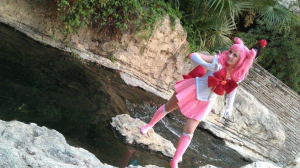
Halloween is over, but this doesn’t stop some people from dressing up all year long.
“Cosplay,” or costume play, is an art form in which participants called cosplayers dress up and act like certain characters from movies, video games or televisions shows. Cosplay originated in the Japanese subculture of manga and anime, but now this secret life of dressing up isn’t so secret anymore. It has made its way to other cultures and even to BYU campus.
BYU student Taylor Winget first cosplayed as his favorite book and movie character, Peeta Mellark, from “The Hunger Games.”
Cosplay was just a hobby for Winget, but his hobby helped make one of his dreams come true.
Creators of the iPhone app Hunger Games: Panem Rising were looking for fans to be characters in the game. Winget took this as the perfect opportunity to put his passion to the test, and he won a spot in the game as a Capitol stylist.
“Cosplay is fun,” Winget said. “You get to take on a persona and become one of your favorite characters, plus I think I look great in my costume.”
Cosplay isn’t just about dressing up; it’s about becoming the character. Professional cosplayers devote their lives to becoming their favorite characters. The website, cosplay.com, was created for the entire cosplay community as a forum and marketplace. Through the website, cosplayers gather inspiration for their characters and learn about the latest techniques to master their looks.
Professional cosplayers buy elaborate wigs and wear makeup to look just like their characters. Some even spend countless hours making costumes that look exactly like the ones worn by their favorite characters.
LA-based YouTube star Kalel Kitten Padilla gained her fame through her channel “Cozplai.” Padilla shows viewers how to recreate the cosplay looks from Snow White, My Little Pony and a video game called Final Fantasy.
Viewers get special tips and tricks from Padilla to master their cosplay looks.
“I tried being normal once,” Padilla said. “But that got too boring, so I went back to being me. I am me when I cosplay.”
Becoming a professional cosplayer is a long process, according to BYU student Jennifer Egan, from Houston, Texas.
Egan spends a few hours a week sewing costumes for upcoming cosplay, film and video game conventions. She spends her free time researching characters and connecting herself to her favorite ones. For Egan, it’s really about relating to and respecting the characters that helped form her imagination. Cosplay is what sets her apart from other BYU students.
“Some people think it’s weird, but that’s okay because cosplay is the secret side of myself that I’m really proud of,” Egan said. “With cosplay you can become a part of yourself that you may be hiding. You don’t have to be afraid with cosplay.”




